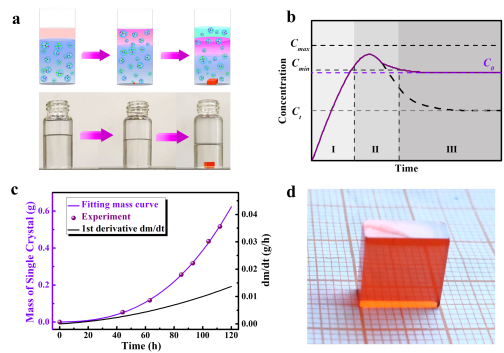On March 4, Nature Communications published the latest research findings on perovskite single crystals by Fang Guojia, Lin Qianqian and Tao Chen’s teams.
The paper is entitled Room-temperature liquid diffused separation induced crystallization for high-quality perovskite single crystals. Wuhan University is the first author affiliation. Yao Fang, a doctoral student from the School of Physics and Technology, is the first author. Fang Guojia, Lin Qianqian and Tao Chen are the corresponding authors.
Halide perovskite materials have been widely used in the photoelectric field in recent years. As an ideal material for exploring intrinsic characteristics of perovskite and optoelectronic devices, perovskite single crystals have been widely studied. At present, the preparation of perovskite single crystals mainly uses inverse temperature crystallization method(ITC), anti-solvent vapor assisted crystallization method(AVC) and low temperature gradient crystallization method(LTGC). The principle of these methods is based on inverse solubility, which can be achieved by changing the temperature or the solvent composition to change the concentration of the precursor and achieve supersaturated crystallization.
Higher temperature (from room temperature to 90 or 60 °C) is required for the growth of single crystals using ITC or LTGC. However, it has been reported that higher growth temperature of perovskite single crystals leads to higher defect density. In addition, it is very difficult to accurately control the rate of temperature change, which may affect the quality of perovskite single crystals and the performance of experimental devices. Therefore, it is of great significance to develop a novel method to achieve the growth of perovskite single crystals at constant low temperature.

The team came up with an idea for the growth of perovskite single crystals at room temperature, and developed a novel method for preparing high-quality perovskite single crystals-- room-temperature liquid diffused separation induced crystallization method(LDSC). With this method, the solvent diffuses into the silicon oil and therefore causes the precursor solution to crystallize. The immiscibility of silicon oil and DMF and the fact that the density of silicon oil is between the density of DMF and that of perovskite precursor guarantee that DMF can diffuse into the upper layer of silicon oil. When the volume of precursor solution is reduced and its concentration is supersaturated, high-quality perovskite single crystals are able to grow. This method can prepare both three-dimensional and two-dimensional single crystals including MAPbX3, PA2PbBr4, BA2PbBr4, PMA2PbBr4 etc. It is a universal method to prepare high quality perovskite single crystals.
In addition, by modeling crystal growth, the team reveals the growth kinetics of perovskite single crystals prepared by this method. Density difference leads to solvent diffusion, reduce in precursor volume and concentration of crystals. Compared with ITC, LTGC, AVC and other methods, LDSC has many advantages including low growth temperature (room temperature), high crystal quality (half-width of rocking curve is less than 0.0096° ) , low defect density (4.4×109cm-3) , long duration (about 1 µs) , high single crystal yield (92%) and universality etc. Moreover, LDSC-MAPbBr3 perovskite single crystals can be utilized in the detection of visible light and X-ray.
Co-corresponding authors of the finding include Professor Liu Chang, Dr. Li Borui, doctoral students Peng Jiali, Li Wenjing, Gui Pengbin, and graduate student Li Ruiming. This project is funded by National Natural Science Foundation of China, Hubei Provincial Science and Technology Program and the Special Fund for Basic Scientific Research Operating Expenses of Central Universities.
Paper Link: https://doi.org/10.1038/s41467-020-15037-x
Rewritten by Liu Tongxv
Edited by: Cao Siyi, Shen Yuxi and Hu Sijia